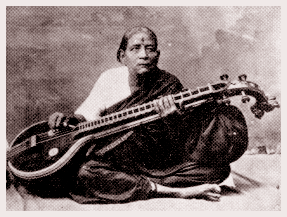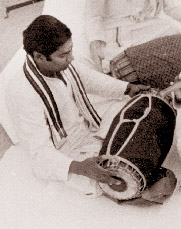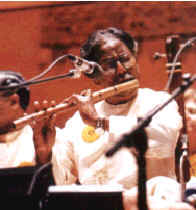|
photo:JanStewart
Guru
Kandappa Pillai (1854-1906)
(Dance master)
Jayammal
(Mother of Bala)
Balasaraswati,
the video
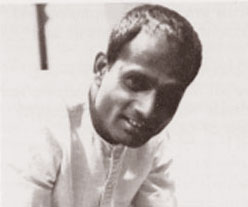
Ganeshan Pillai
(nattuvanar)
|
Veena Dhanam
(1867-1939) (Grand mother)
Lakshmi
(daughter of T. Balasaraswati)
(Lakshmi
performing)
Aniruddha
(son of Lakshmi and
Douglas Knight)
Ganeshan
Pillai (Son of Kandappa)Nandini
Ramani (Student of T. Balasaraswati and Ganeshan Pillai)
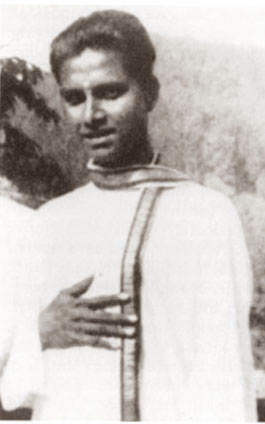
Kandappan Pillai
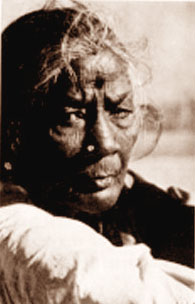
Jayammal (mother
of BALA)
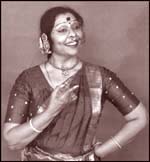
Lakshmi
Knight
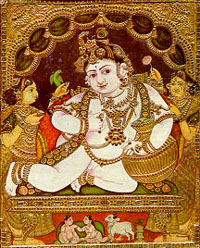
Tanjore Court painting(18th to 19th Centuries)
Lord Krishna
 |
In the history of dance, we find every now and then a supreme artist who dominates the field for a
generation, enriching the existing tradition, providing a corrective to current practices and
setting standards for generations to follow. Anna Pavlova was one such artist and so was Vaslav
Nijnsky. And today in India Balasaraswati is one. The great dancer, the really great dancer, is
perhaps an even rarer phenomenon than great musicians or painters or sculptors. This is because the
dance is the consummation of all the arts. The dance, in addition to the qualities that pure
dancing demands, must be sensitive to and have an uncanny feeling for music. He or she should have
an artist's sensibility to the significant line and a sculptor's approach to form. He should have
a practiced actor's response to a dramatic situation. Rarely does one come across all these attributes in
one and the same person. But when one does, and Balasaraswati has a generous measure of all these,
the result is greatness.
The flowering of Balasaraswati's genius has taken place in a garden of great splendor. For generations, the
family has been a repository of the Karnatic tradition in its pristine glory. The family tree can be traced back
to over two hundred years. Every branch is dotted with music and dance. Balasaraswati's great-great-great-great
grandmother, Papammal, was a musician and a dancer at the Tanjore Court. that was in the eighteenth century.
Papammal's daughter, Rukmini, was also a court musician at Tanjore. By the time we come to Rukmini's daughter, Kamakshi
(circa 1810-1890), the picture is clearer and more details are available. She had been taught by the great
Ganapati Sastri and danced at the Tanjore Court till the age of seventy-five. Of Kamakshiammal's children, two were famous.
One was her son Apparkkannu who took to the violin, at that time a newcomer to the Indian musical scene, and attained
considerable mastery over it; the other was her daughter Sundarammal (circa 1820-1888). Both were pupils of Subbaraya
Sastri, and himself a composer of great qualities who has perhaps not had the recognition due to him. It is on record
that Subbaraya Sastri taught the well known kriti, Nannu brochutakau in Todi to Ponnuswamy and
Sundarammal.
While learning the kriti they sang the phrase Mayamma Kamakshi with such inspiration and feeling that
Sastri said that the Goddess Kamakshi certainly belonged to them. The family and their descendants today are thus a
repository of the compositions of Syama Sastri and Subbaraya Sastri and the most authentic interpreters of their works.
It is also to the credit of Ponnuswamy that he persuaded his neice and Sundarammal's daughter,
Veena Dhanam
(1867-1939),
to
take up the Veena. No finer or more sensitive exponent of the instrument is known in the history of Karnatic music.
The Veena was her natural vehicle of expression (though she was also a vocalist of the highest quality), and her music
was the quintessence of the Karnatic tradition.
Veena Dhanam and her sister Rupavati both practised dancing for some time; so did Balasaraswati's mother Jayamma and almost
every other member of the family. Music and the dance reigned supreme in the household. The family was an inspiration for
composers and teachers alike. First there was the association of Subbaraya
Sastri. Then there was Sattanur Panchanadier, a
pupil of Muthuswami Dikshitar, who taught music to Veena Dhanam and Rupavati. Patnam Subramania Iyer taught Dhanam's daughter.
A great many of the javalis of Dharmapuri Subbarayar were composed in that home.
It was into such a treasure-house
of
the Karnatic tradition that Balasaraswati was born on the 13th of May, 1918. Music and dancing
were in her blood. And music and dancing were all around her. And they were, of course, music and dancing of the highest quality
and practised and heard in abundant measure. Her formal training started at the age of four under the late
Kandappan.
Kandappan himself was the inheritor of a great tradition. For over six generations, the family were nattuvanars, dance teachers.
Kandappan's great-great-great grandfather Gangamuthu must have been a contemporary of
Papammal. Two generations later we come to the
celebrated Tanjore quartet-Chinnayya, Ponniah, Sivanandam, and Vadivelu- all of them teachers and composers of the highest standards.
Kandappan was the great-grandson of Chinnayya, the eldest of the Quartet. Kandapan's father, Nellayappan (1854-1906) was perhaps the finest
teacher of his time. Kandappan born in 1899, died prematurely in 1941 at the age of 42. The tragedy of his early death is alleviated
only by the fact that he trained with a devotion rare even in those days of dedicated teachers the greatest Bharata Natyam dancer of
our age.
[Kandappa's son, Ganeshan Pillai, was trained in music and dance in Jayammal's house. He became Balasaraswati's nattuvanar at an early age.
Unfortunately, he died in 1987, but he too left an impressive legacy of teaching, music and dance compositions. Dancers who have studied with him;
Nandini Ramani (Daughter
of the distinguished Sanskrit scholar Dr. V. Raghavan), many of
Nandini's students, her sister Premavada, the well-known Dutch Sanskrit scholar Saskia Kersenboom Von
Duran, Sushama
(Nandini's daughter), and Kay Poursine continue to perform and teach
his compositions.]
Balasaraswati's Arangetram (debut) took place in her seventh year at
Kancheepuram at the Amanakshi Amman temple. The great Nayana Pillai
was present at the Arangetram. Word had gone round in Kancheepuram that the great Dhanam's grand-daughter was to dance at the temple and
there was an enormous crowd. But the seven-year-old child betrayed no signs of nervousness and astonished those present with the exactitude of her
rhythm and the precision of her movements. "Tremendous" was the word with which the excited Nayana Pillai summed up the evening.
Soon she was in great demand for public performances. But life was by no means a bed of roses. Those were the days of the Devadasi Bill. While
veteran musicians and connoisseurs went into ecstasies over her art, there were others who scoffed at the practise of Bharata Natyam as a
profession. But Jayammal, her mother, stood firm. The result was not only a personal triumph for Balasaraswati, but the preservation and the
strengthening of a great and ancient tradition.
No dancer captured the public imagination as Balasaraswati did in the thirties and forties. Bharata Natyam to the public until then was an esoteric
art practiced for the pleasure of a few connoisseurs and dilettantes. Outside the pale of the temple [and court] there were hardly any public
performances. Balasaraswati made the public aware of Bharata Natyam, not by deliberate efforts as a reformer, but by the beauty and the eloquence
of her dancing. It was left to others to fight prejudices and stupidity, do research, delve into the past, give the dancer's profession
respectability and so on.


photo: Jan Steward
Aniruddha
BALA
son of Lakshmi
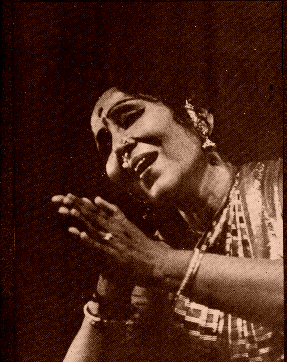
"In
Loving Memory"
Lakshmi Knight (1943 –
2001)
by Kay Poursine
Lakshmi Knight, the only
daughter of T. Balasaraswati, died December 23, 2001 in her mother’s house in
Kilpauk, Chennai. When I last saw Lakshmi, she was in a St. Francis Hospital
cancer ward bed, Hartford, Connecticut. She told me she was determined to get on
a flight to Chennai. It seemed possible to her at the time, that if she could
get to her beloved mother’s house, maybe, just maybe, she would feel better
and perhaps miraculously begin to heal. Muni, her long time close friend and
assistant stood at her bedside and looked at me in despair. I reminded Lakshmi
that if she left Muni behind in the U.S. he could not make his famous decoction
coffee for her every morning. Lakshmi smiled and we teased him in the way I
always loved. His coffee and cooking are superb. As I left Lakshmi’s room that
day, I blew her an abhinaya kiss. She smiled a beautiful broad smile. Then her
face reflected something astonishing. Perhaps I was seeing her knowledge and
wonder at the mystery of what was ahead of her.
My first visit to India was
a surprise. In 1976 Bala and Lakshmi sent a formal written invitation to both
Kamala Cesar Buckner and me to study in what was then called Madras for 6
months. Kamala is presently the creator and director of Lotus Fine Arts in
Manhattan. Both Kamala and I had previously taken classes in Bala’s summer
residencies in 1973, 1974 and 1975 in California and Washington. I think this
invitation was a leap of faith for Bala, especially when it was known that she
was not inclined to teach westerners in India. The prospect of going to India
did not hold the big fascination for me that it did for many westerners. India
scared me. Kamala and I flew to Madras, then experienced all the incredible ‘firsts’
that most westerners encounter on their first visit to India; intoxicating
aromas of jasmine, sambar, idlis, roasting arabica coffee beans, temple camphor
mingling with the strong pungent odor of the Kaveri river. I got sick several
times. Bala worried and Lakshmi gave moral encouragement. Studying dance in
India was harder than I had imagined. In six months Kamala and I learned
complete programs of Bharata Natyam every dance chosen in advance by Bala. It
was important that each dance suite our level of skill and most important fit
our temperaments. Toward the end of my stay Lakshmi offered to sing in the
recording for the padam Velavare. Velavare was an ‘advanced’ dance as far as
I was concerned. Lakshmi’s voice on the recording is sensual, like a lark
calling out for its mate and full of the essential emotion in the padam. To my
surprise Lakshmi was cautious about how her voice sounded on the recording and I
didn’t understand why. When Bala listened to the final tape, proudly nodding
her head in approval, I was deeply moved by the glow of humble satisfaction on
Lakshmi’s face. I then realized how difficult it was for Lakshmi to develop
artistically under the watchful gaze of the great Balasaraswati.
How can I explain the loss
of someone who I see in my mind’s eye inseparable from another? I see Lakshmi
and Bala as one, especially when Lakshmi was performing or teaching class.
Lakshmi had extraordinary sophistication combined with a luxurious sensuality
and playfulness that infused everything she did. My fondest memories of both
Bala and Lakshmi are happy excursions to the Mylapore Kapaleeswarar temple,
shopping at the temple tank market, picking out the perfect sari, sitting on
Bala’s veranda in the cool of the late Kilpauk afternoon and teasing each
other about one silly thing or other. Coming back from an evening concert or a
favorite dining and dancing spot, I got used to Bala sitting with Lakshmi in
their living room asking for my ‘report’ on the evening. Although at first I
took exception to it, I came to realize and be thankful that both Bala and
Lakshmi felt a great responsibility for my wellbeing. I miss this too much. How
can you bring back someone’s laugh, or the way they tease you? I believe they
are together now enjoying each other’s company, laughing, joking, dancing and
singing in the grandest of saris.
The close bonds Bala and
Lakshmi shaped with the American dancers who found inspiration in their company
and teaching are an important part of the continuing life of this rare dance and
music tradition. I have often wondered at my good fortune in seeing the
incomparable artistry of Bala on stage and in class, having the opportunity to
learn from both Bala and Lakshmi, and watching Lakshmi blossom into an
extraordinary artist. Their legacy continues in the minds and hearts of the
dancers they guided into this timeless tradition.
T.Viswanathan
( 1927 – 2002)
"A Sound like
No Other" A Tribute
By Kay
Poursine
T. Viswanathan, brother of
T. Balasaraswati and T. Ranganathan and uncle of Lakshmi Knight, died
September 10, 2002. His death is a monumental loss for the music world. He was
the epitome of the great Vina Dhanammal family music tradition. When he played
his flute or sang everyone heard a rare musical expression at one with nature.
Three days before he died,
I accompanied Viswa to the Sri Satyanarayana Temple’s dance drama fund
raiser in Hartford, Connecticut where he gave his blessing at the beginning of
the performance. During our return trip to Middletown, he told stories of
performances with Bala, his mother Jayammal, the great mrdangist T. Kuppuswami,
and Ranga his brother, with the young Lakshmi sitting on the side devotedly
assisting the family group. Recalling the evening Bala performed for the
Maharaja and Maharini of Travancore, Viswa described the royal puja room where
Bala danced. The program consisted exclusively of Maharaja Sri Swati Tirunal’s
compositions. "The performance blew everyone’s minds. So many stories
to tell, Kay, so many stories." I sat in the back seat wondering if I
would ever hear them all.
My first Karnatic singing
class was at Mills College during Bala’s residency in 1972. I had no idea
what was expected when I heard that it was necessary for every dancer to learn
the music for the items Bala taught; the kriti Natanam Adinar, the padam
Alolam and Kalyani Jatiswaram. Viswa taught singing and his brother, Ranga,
taught nattuvangam for tisram alarippu. I remember hearing Viswa’s concert
the night before Bala’s performance and was mystified that we were expected
to learn this incredible music. As I sat in that first class with Viswa
patiently guiding the American dancers through the first swara exercises, I
was in awe of his attention to details in the tones and sounds that at that
time I did not hear. The subsequent vocal classes with Viswa at Wesleyan were
a great challenge for me. Viswa wanted not only excellence from his students,
but also a student to develop a refined sense of taste so famously exemplified
in the artistry of his family. Because of his teaching, I hear the universe
when I dance.
I think there are many
people who miss Viswa terribly, above all his wife, devoted student, and soul
mate, Josepha who must endure this heartbreaking time. His passing is
particularly difficult for his current students. They must accept the
unacceptable. He can not be replaced, but will remain in our hearts and minds
forever. He has taken his place in that extraordinary family group with his
beloved Bala, Lakshmi, Ranga, Jayammal and Dhanamal.
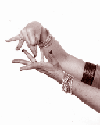
Back
to Kay Poursine
kpoursine@wesleyan.edu
Copyright ©2001 Kay Poursine. ® All rights reserved ®
|
